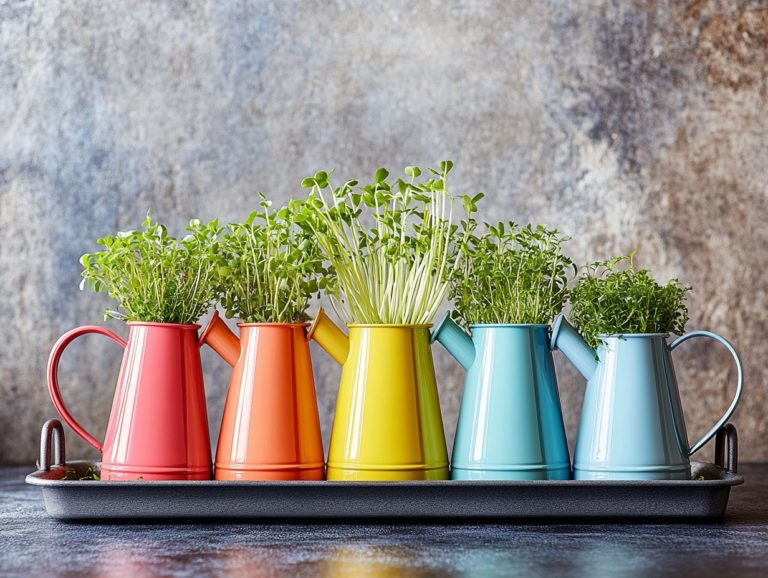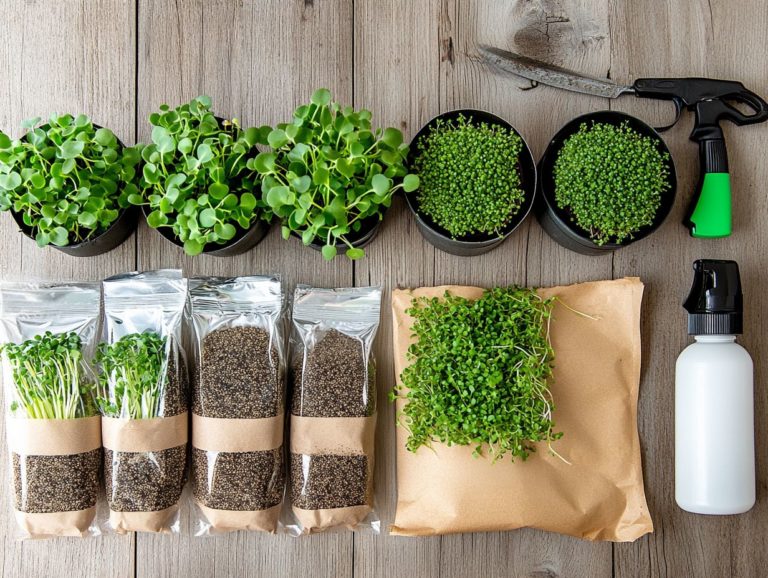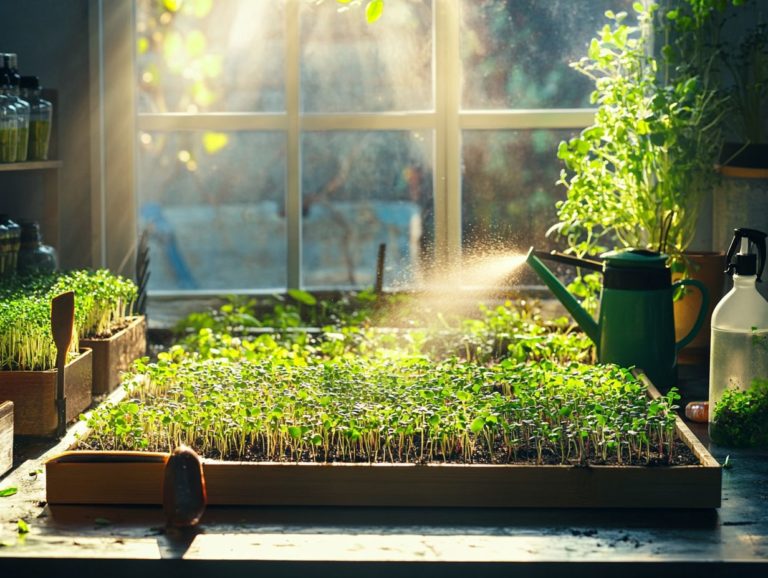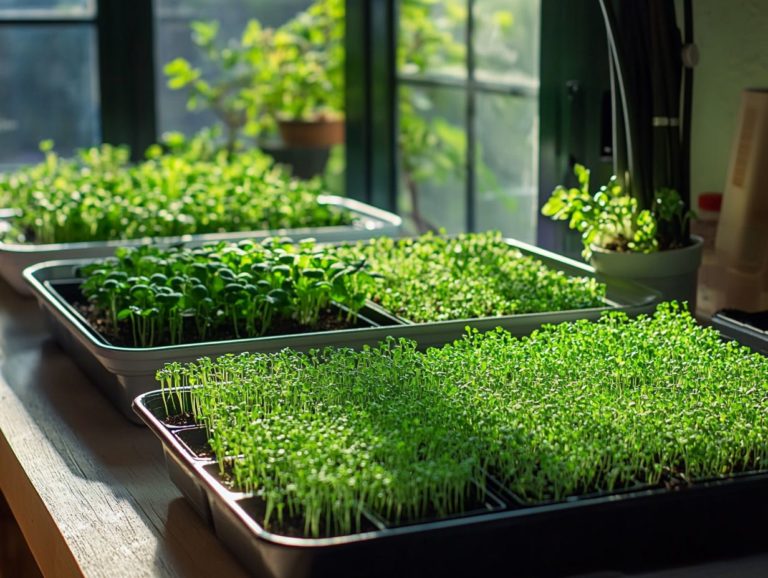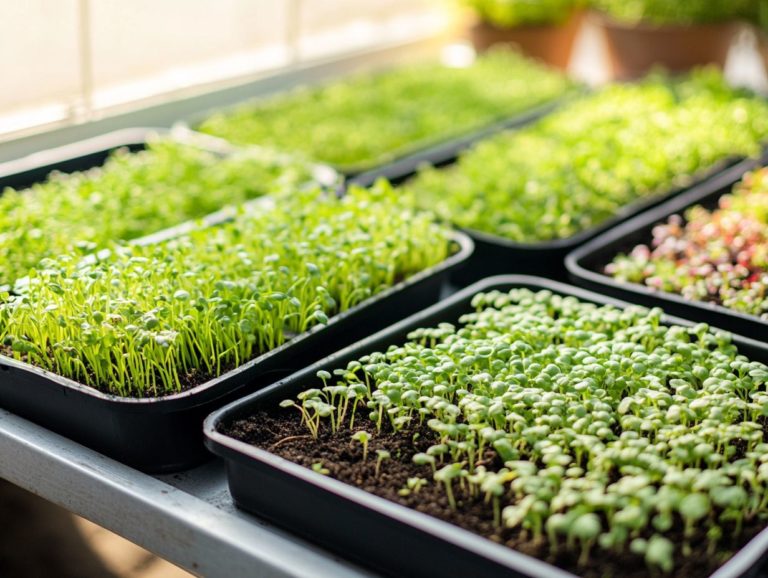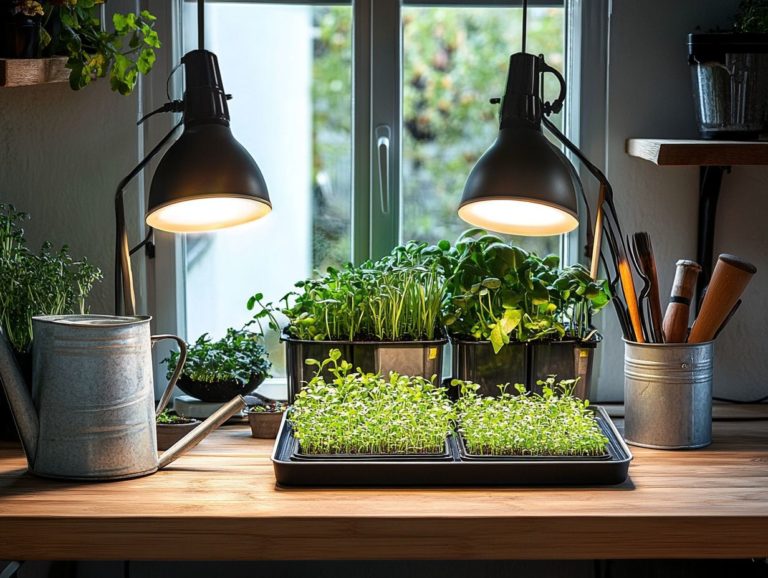5 Essential Tips for Microgreen Equipment Care
Microgreens are small, nutrient-rich plants that health enthusiasts and aspiring gardeners love. They provide a great nutritional boost and a rewarding experience in home gardening.
This article explores the many benefits of growing microgreens. You will learn how they can enhance your meals and save money.
We will guide you on selecting the right equipment and maintaining it effectively. You’ll also find solutions for common challenges.
Whether you’re starting with microgreens or looking to enhance your experience, these tips will make your journey rewarding.
Contents
- Key Takeaways:
- Benefits of Growing Microgreens
- Choosing the Right Equipment
- Proper Care and Maintenance of Microgreen Equipment
- Maximizing the Lifespan of Your Equipment
- Troubleshooting Common Equipment Issues
- Frequently Asked Questions
- What are the top 5 tips to care for microgreen equipment?
- Why is regular cleaning important for microgreen equipment care?
- How should I store my microgreen equipment?
- What should I do to maintain my microgreen equipment?
- Why is it important to use high-quality equipment for growing microgreens?
- What advice should I follow when using my microgreen equipment?
Key Takeaways:
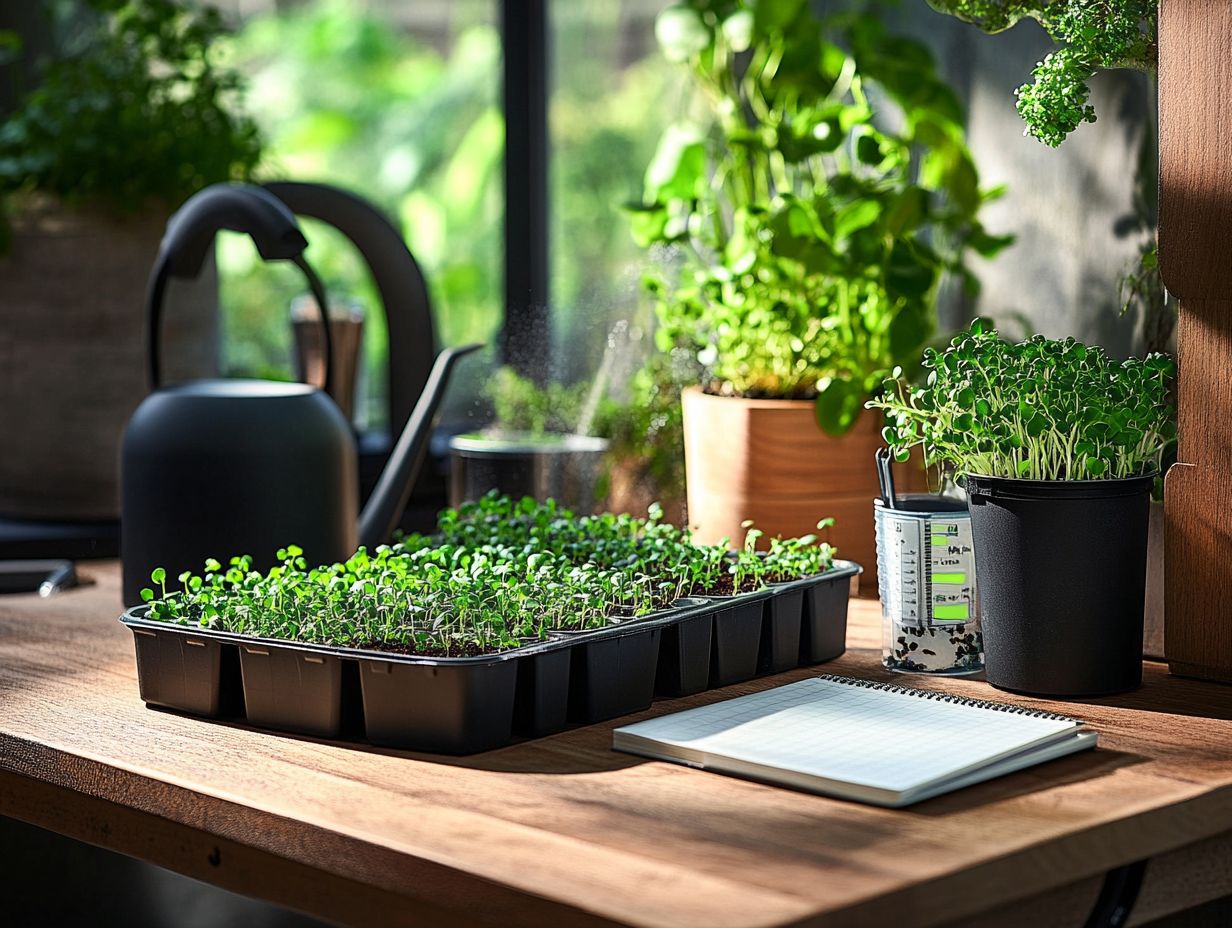
- Keep microgreen equipment clean and sanitized to ensure food safety.
- Store and replace equipment properly to save money over time.
- Troubleshoot common issues promptly to prevent costly delays.
What are Microgreens?
Microgreens are young plants harvested within 7 to 21 days after germination. They include nutrient-dense vegetables like arugula, broccoli, and sunflower shoots.
These vibrant greens are bursting with flavor and packed with health benefits. They offer high levels of potassium, iron, and zinc, making them essential for a healthy diet.
You can grow various microgreen varieties, from classic herbs like basil and cilantro to unique options like radish and beet greens. They require minimal space and can thrive in different growing mediums like potting soil or coconut coir.
To start your home garden, pick up vegetable seeds from a local nursery or order online. The process is simple:
- Sow the seeds densely.
- Cover them with a light layer of your growing medium.
- Ensure they receive enough light and moisture.
As they grow, these greens will not only enhance your meals but also boost their nutritional value. They are a smart choice for anyone aiming for better health.
Benefits of Growing Microgreens
Growing microgreens boosts the nutritional value of your meals and saves you money on fresh produce. They are perfect for health-conscious individuals and home gardening enthusiasts.
With their compact size, you can easily grow them on your windowsill. Their vibrant flavors elevate any dish, opening up a world of culinary possibilities.
Microgreens grow quickly, providing a steady supply of fresh greens for your cooking. This keeps your home garden productive year-round.
Nutritional Value and Cost Savings
Microgreens are known for their remarkable nutritional value. They often have higher concentrations of vitamins and minerals than mature plants.
These tiny powerhouses contain vital nutrients like potassium for heart health, iron for energy, and zinc for immunity.
By growing these greens at home, you can enjoy fresh options without the high price of organic produce. They are budget-friendly and versatile, enhancing dishes from vibrant salads to refreshing smoothies.
Incorporating these nutrient-dense varieties into your meals promotes vibrant health while being kind to your wallet.
Choosing the Right Equipment
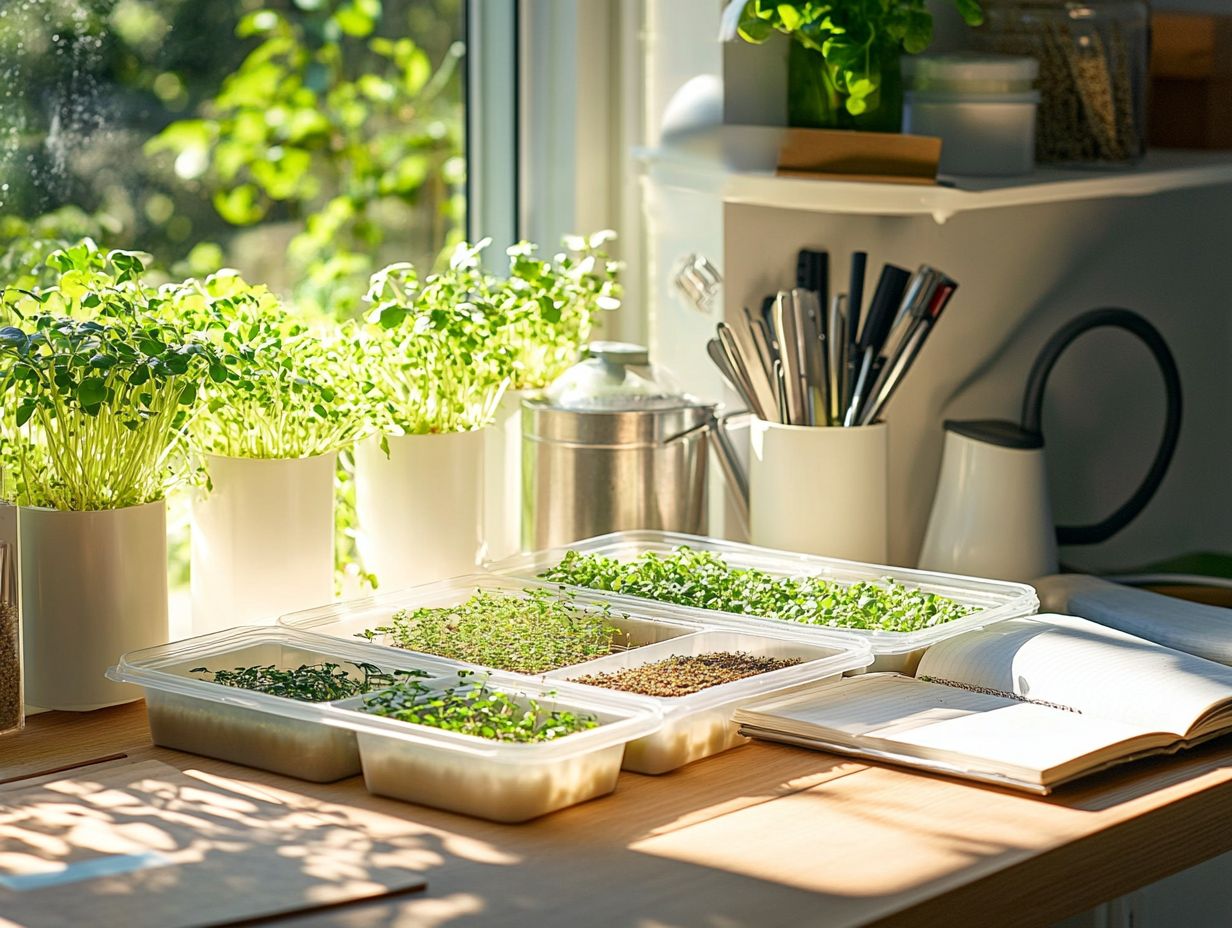
Selecting the right equipment is essential for your success in growing microgreens, as it sets the stage for ideal germination and plant growth. From choosing the perfect growing medium be it peat-based mixes or coconut coir to the appropriate containers and growing trays, every element significantly influences the development of your microgreens.
Having the right garden tools makes the process easier. Tools like scissors for harvesting can simplify your gardening experience, ensuring that both newcomers and experienced gardeners find it easier to cultivate these nutrient-rich greens right at home. Maximize your microgreens harvest efficiently!
Types of Equipment and Their Uses
In terms of growing microgreens, having the right equipment can truly elevate your gardening experience and ensure successful cultivation. Growing trays are essential they offer ample space for your seedlings to thrive.
Containers help with proper drainage and air circulation, both vital for the health of your microgreens. Investing in essential garden tools, like watering cans and scissors, greatly enhances your maintenance and harvesting efforts, allowing you to manage your indoor gardening project with ease. For optimal results, consider following these 5 tips for successful microgreen germination.
Don t overlook other key tools, such as humidity domes, which create that perfect moisture-rich environment for seed germination. Grow lights provide the essential light spectrum for robust photosynthesis.
A pH meter a tool that measures how acidic or basic your nutrient solution is will help you keep your nutrient solution at optimal levels. Additionally, a seedling heat mat ensures that your seeds get the warmth they need for quicker sprouting seeds.
Utilizing these tools not only streamlines the process but also maximizes the yield and quality of your microgreens. This results in a more rewarding indoor gardening experience, ensuring you reap the benefits of your efforts.
Proper Care and Maintenance of Microgreen Equipment
Caring for and maintaining your microgreen growing equipment is crucial for maximizing longevity and effectiveness. It helps prevent the spread of diseases and pests that could jeopardize the health of your plants and impact your microgreens harvest.
Make it a habit to regularly clean and sanitize your tools and containers. Ensure all organic residues and contaminants are meticulously removed from your indoor gardening setup to promote a healthier environment for your microgreens.
Regular cleaning not only keeps your microgreens healthy, but also boosts your gardening success. This paves the way for vibrant growth and optimal yields for your indoor gardening efforts.
Cleaning and Sanitizing Techniques
Cleaning and sanitizing your microgreen equipment are essential steps in cultivating a thriving growing environment. These practices help prevent contamination and diseases that could adversely affect the quality of your crops.
To achieve optimal results, adopt specific cleaning methods tailored to the various pieces of equipment you use. For example, trays and pots benefit greatly from a thorough scrub with warm, soapy water, followed by a rinse and soak in a diluted bleach or vinegar solution to eliminate all contaminants.
Even the smallest items, such as scissors and seedling markers, require regular sanitizing to prevent cross-contamination. By prioritizing equipment maintenance, you ll enhance the productivity of your gardening space and foster the overall cleanliness necessary for your microgreens to flourish.
This disciplined approach to hygiene can significantly reduce crop failures. Start setting up your equipment today for the best results!
Maximizing the Lifespan of Your Equipment

To maximize the lifespan of your microgreen equipment, implementing proper storage and maintenance practices is crucial. By safeguarding your investment in a clean, dry environment, you can prevent damage and deterioration of your garden tools and growing trays.
Regular checks and thorough cleaning are your allies in extending their usability. Be careful to replace worn or damaged equipment to maintain optimal growing conditions for your microgreens. For more information, consider these essential tips for growing microgreens at home. This paves the way for successful harvests and healthy crops year after year!
Storage and Replacement Tips
Effective storage and timely replacement of your microgreen equipment are crucial strategies for maintaining a productive indoor gardening setup. Keeping your growing trays and garden tools organized in a dedicated space not only prevents clutter but also ensures easy access during planting and harvesting.
Utilizing labeled containers for different seed varieties streamlines the planting process and helps you track what s thriving in your garden. Implementing shelving units can maximize your vertical space, allowing for an efficient arrangement of tools and supplies.
Establishing criteria for replacing equipment is equally vital. If your trays show signs of wear or your tools no longer perform as they should, it s time to consider replacements. This will help uphold a quality growing environment.
Assess your storage now to boost your microgreen success! Regularly review your maintenance practices to contribute significantly to the overall success of your microgreen project.
Troubleshooting Common Equipment Issues
Troubleshooting common equipment issues is a vital skill for any microgreens grower. This enables you to swiftly address problems that could impede plant growth or yield.
Challenges such as inadequate drainage, mold formation, or damaged tools can significantly affect the success of your indoor gardening endeavors. By getting ahead of problems and recognizing these potential issues early, you can implement best practices for indoor microgreens that keep your microgreen garden vibrant and productive.
Identifying and Addressing Problems
Identifying and addressing problems promptly can be your key to saving a microgreen crop from potential failure. This ensures a thriving indoor gardening environment!
Common issues like overwatering, poor drainage, or inadequate light can lead to stunted growth or pest infestations. By recognizing these signs early and taking corrective measures such as adjusting how you water your plants or relocating your growing trays, you can effectively safeguard the health and vitality of your microgreens. For more insights, consider the 5 key factors for successful microgreen growing.
Regular equipment maintenance is essential to prevent complications. Make it a habit to check the moisture levels in your soil and ensure that the trays have adequate drainage holes to avoid waterlogging. Additionally, be aware of the top 5 mistakes in growing microgreens to optimize your success.
If you notice yellowing leaves or lackluster growth, it might indicate insufficient light. Consider enhancing your light source or moving the trays closer to a window. Pest issues, such as aphids or mold, require immediate attention! Employing organic pesticides or increasing airflow can make a significant difference.
By staying careful and proactive in observing these symptoms, you can cultivate a flourishing crop of microgreens!
Frequently Asked Questions
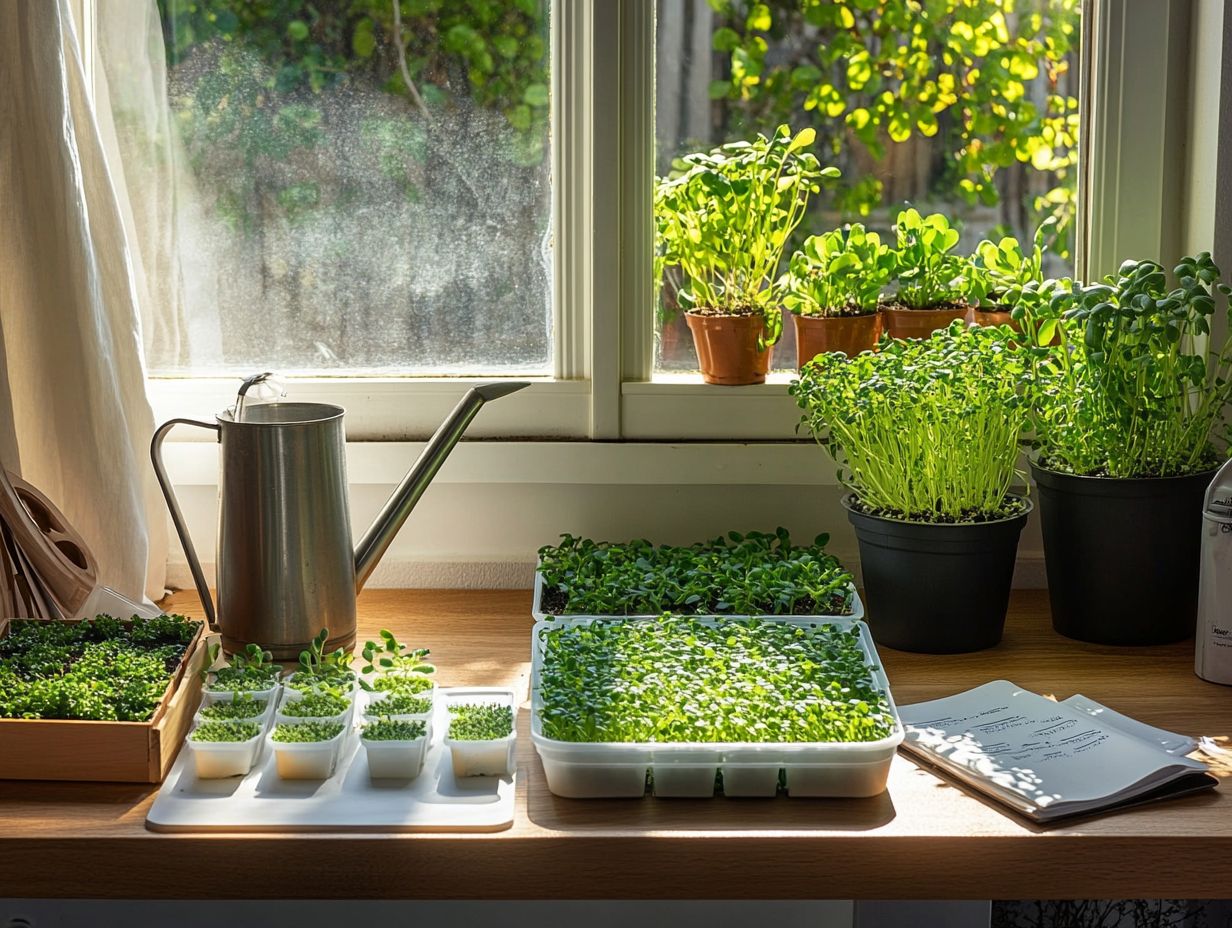
What are the top 5 tips to care for microgreen equipment?
The top 5 tips for microgreen equipment care are: regular cleaning, proper storage, maintenance, using high-quality equipment, and following the manufacturer’s instructions.
Why is regular cleaning important for microgreen equipment care?
Cleaning your equipment is super important! It helps keep bacteria and mold away, which can affect the quality of your microgreens. It also extends the lifespan of your equipment.
How should I store my microgreen equipment?
Microgreen equipment should be stored in a clean and dry place, away from direct sunlight. Ensure that the equipment is properly dried before storing to avoid rust and corrosion.
What should I do to maintain my microgreen equipment?
Regular maintenance is crucial for your microgreen equipment. Check for any damage or wear and replace worn parts as needed.
Follow the maintenance schedule provided by the manufacturer to keep everything functioning well.
Why is it important to use high-quality equipment for growing microgreens?
Using high-quality equipment helps your microgreens grow better and ensures a successful harvest.
It also lowers the chances of equipment failure and contamination.
What advice should I follow when using my microgreen equipment?
Always follow the manufacturer’s instructions for assembly and operation. This ensures safety and prevents damage to your equipment.

